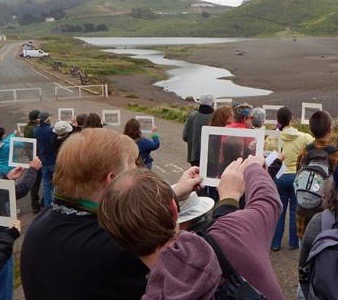 At our Climate Change Science and Communication course in San Francisco, we enjoyed a half-day field trip out to the Marin Headlands in Golden Gate National Recreation Area. During that trip, participants were treated to a field experience where they looked at the landscape through “magic windows” enabling them to see the past, literally, in the context of our modern day. Collectively, the group speculated about using this tool to envision a future landscape as well, possibly helping the viewers to come to a better understanding of the possible implications of a changing climate. We all thought it would make a great example to share with the whole EtS community.
At our Climate Change Science and Communication course in San Francisco, we enjoyed a half-day field trip out to the Marin Headlands in Golden Gate National Recreation Area. During that trip, participants were treated to a field experience where they looked at the landscape through “magic windows” enabling them to see the past, literally, in the context of our modern day. Collectively, the group speculated about using this tool to envision a future landscape as well, possibly helping the viewers to come to a better understanding of the possible implications of a changing climate. We all thought it would make a great example to share with the whole EtS community.
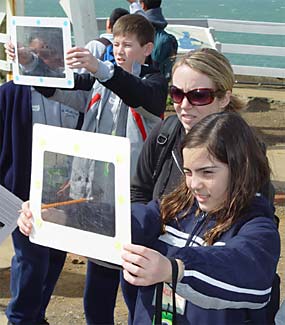 Golden Gate National Recreation Area - California
Golden Gate National Recreation Area - California
Rangers at Golden Gate have been telling students stories about the past for years. It can be difficult to accomplish at times, especially when the view seen by visiting groups today, is very different from what it was in the past. They focused, therefore, on one essential question - “How do we recognize evidence of change in this environment?” The park’s archives of Point Bonita are rich in historic photos, some by the famous Eadward Muybridge. The peninsula is exposed to occasional violent storms—landslides are common. The historic photos document 150 years of human interaction with a dynamic landscape with plenty of evidence of erosion and weathering of rocks. That make excellent props for discovery. Today in the Marin Headlands, changing climate brings a new challenge for the students. There’s another question being asked - about how to recognize change taking place right now, and how it’ll be impacting this place in the future. Their toolbox of appropriate techniques for addressing these questions contains some great tools, including a new one called “Magic Windows.”
Creating the Teaching Tool
For many years, rangers and lighthouse docents have successfully used a selection of historic photos during tours to illustrate aspects of the area’s history. To better engage students, the challenge was to find a way to illustrate geologic processes through these historic and contemporary photos and to create an “overlay” that could be used as each viewer looked at a particular scene. The teaching tool developed needed to be suitable for an outdoor program: inexpensive, portable (able to fit into a day pack), durable, and able to withstand exposure to varying weather conditions.
 Their first effort involved making a grayscale image of a historic photo, then copying it onto transparency film and mounting the image on an overhead transparency frame. The photo contained so much visual information that it was difficult to focus on the example of geologic change the photo highlighted. They then used the historic photo to make a pen-and-ink drawing of the photo and decided which elements of the photo were necessary to include in the Magic Window, and which could be dropped, or de-emphasized. This process worked well, and produced suitable images.
Their first effort involved making a grayscale image of a historic photo, then copying it onto transparency film and mounting the image on an overhead transparency frame. The photo contained so much visual information that it was difficult to focus on the example of geologic change the photo highlighted. They then used the historic photo to make a pen-and-ink drawing of the photo and decided which elements of the photo were necessary to include in the Magic Window, and which could be dropped, or de-emphasized. This process worked well, and produced suitable images.
Next, the park experimented with two types of images: one category included historic views; the other used contemporary photos to highlight recent geologic activity. It turned out, the historic photo windows were better at getting the students engaged. Once they had all their investigation images on transparency film, it was time to assemble the windows. Three overhead transparency mounting frames were stapled together to create a window strong enough for repeated outdoor use, even in misty weather or light rain. Captions with compass bearings were added to each window. For each investigation, they provided students with the Magic Window, a resource sheet about the investigation site that included the historic photo, and an investigation worksheet that listed the step-by-step inquiry procedure.
Using Magic Windows in the Field
Students are assigned to work in pairs to line up the windows, but each student has a clipboard with their own map and worksheet. Leaders distributed the resource information sheets midway through the investigation, after students have taken notes, asked their first question and written a possible answer. This process has worked well with middle and high school audiences, and yields inquiry related to that essential question about observing change in the environment. During one of the early programs, Francisco Middle School teacher Kelly Taggart coined the term “Magic Window” for the transparencies, and the name has been used ever since!
Using Magic Windows in the Classroom
For the classroom sessions, interpreters bring a Magic Window image into the class and focus upon a 1930s black-and-white poster of the Golden Gate Bridge under construction. It’s relatively easy to line up a window with the central element of the poster: the bridge. And it’s fairly straightforward to draw a Magic Window showing the Golden Gate in the 1800s. Students just eliminate the bridge from the image and draw a clipper ship approaching the Golden Gate.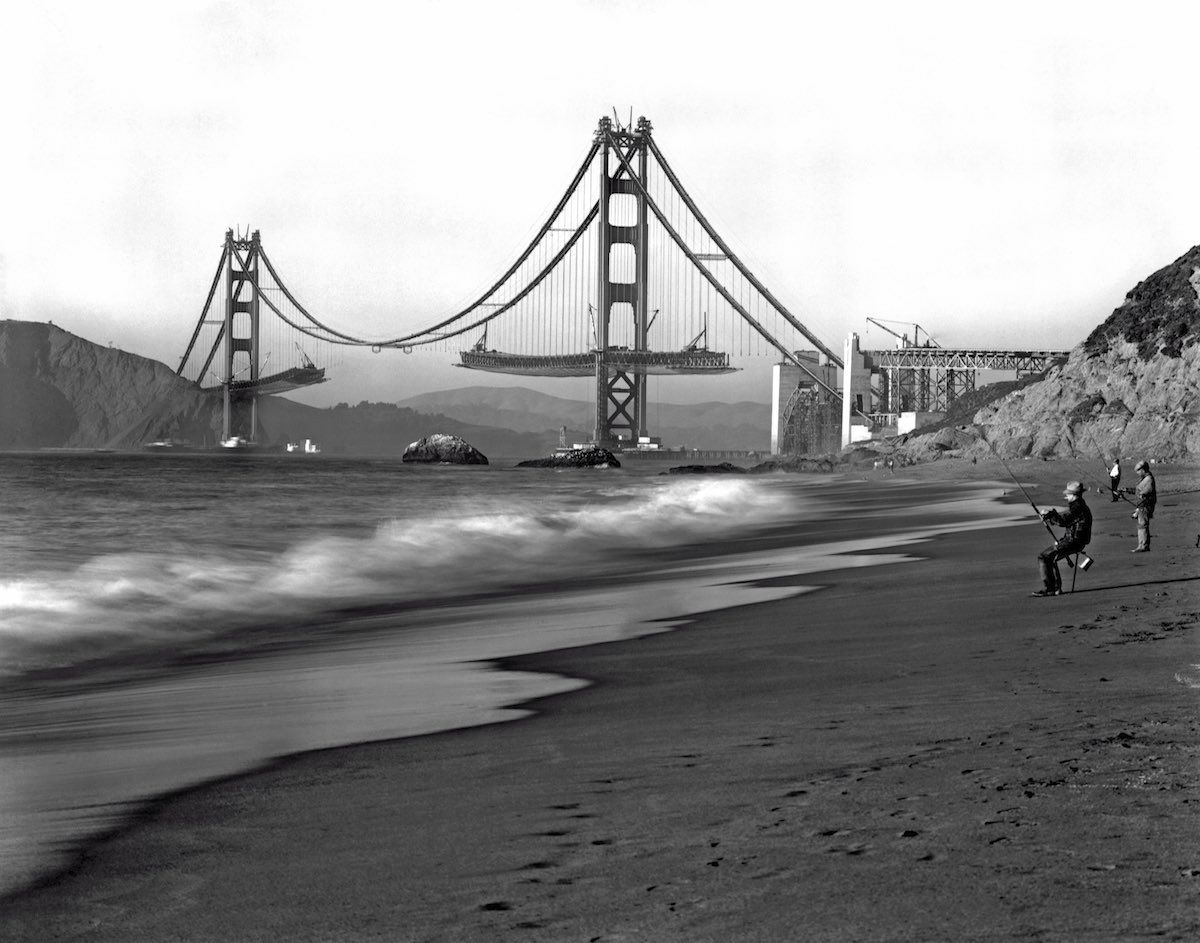 The poster and 1800s image give students a chance to think about time (i.e., history), but not geologic change. In order to generate observations and questions about geologic change, they use another window, one that either illustrates possible geologic change that occurred in the past, or imagines possible future change. While geologists primarily are viewed as investigators of Earth history, looking very deep into the past, much of the science of geology is aimed at being able to predict future events, such as earthquakes, tsunamis, landslides, and the impact of climate change. Students are able to draw a window showing the Golden Gate Bridge, but with elevated sea level, and a space-age transport flying over the bridge.
The poster and 1800s image give students a chance to think about time (i.e., history), but not geologic change. In order to generate observations and questions about geologic change, they use another window, one that either illustrates possible geologic change that occurred in the past, or imagines possible future change. While geologists primarily are viewed as investigators of Earth history, looking very deep into the past, much of the science of geology is aimed at being able to predict future events, such as earthquakes, tsunamis, landslides, and the impact of climate change. Students are able to draw a window showing the Golden Gate Bridge, but with elevated sea level, and a space-age transport flying over the bridge.
After students line up the Magic Windows, they are guided through a simple inquiry process using the following key questions:
What timeframe does the poster represent? How do you know?
What timeframe does each Magic Window represent? How do you know?
How is each window different from the poster? What is the same?
What questions do you have about your observations?
Do the Magic Windows illustrate processes that may change the Earth’s surface?
Explain.
How do you recognize geologic change in your environment?
Can knowing how to recognize processes of geologic change in your environment help your community? How?
During the inquiry, students use their own definitions of environment. The essential question, “How do we recognize geologic change in this environment?” is meant to be flexible, because the environment may be global, or local, even just their neighborhood. By keeping the essential question flexible, all students will have knowledge or experience of geologic change in their environments, and the question is applicable to park and non-park settings.
Assessing the Results
It was found that including the Magic Window activity and discussion in the classroom improves the field program: Students remain focused on the geology theme of their visit and are able to discuss the essential question. They conduct a simple assessment of students’ experiences at the end of the field program by having each student write answers to two questions:
1. What is an example of geologic change?
2. How did your visit to the park make it easier to learn about earth science?
Further assessment is also available for the teacher when students return to class and complete the post-visit lessons.
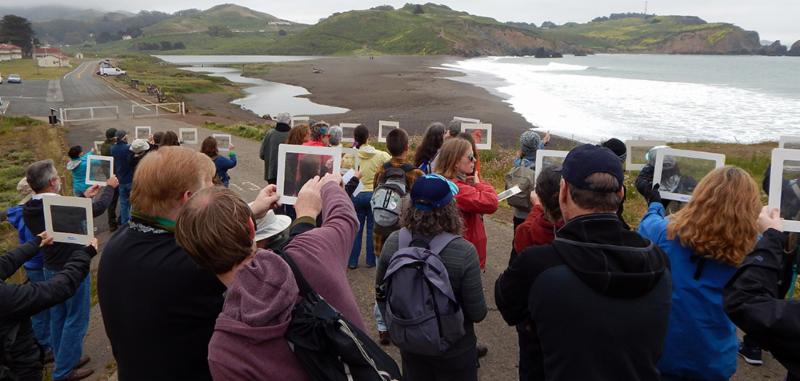
The Magic Window technique can be part of an inquiry discussion in the classroom, outdoors, or in any neighborhood. Although this teaching tool was developed for a geology curriculum, Magic Windows could be used in a variety of disciplines in which time and landscape are components.
Related References:
Contact for more details:
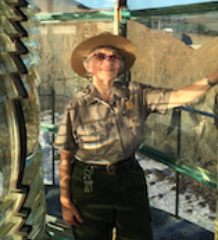 Roxi Farwell
Roxi Farwell
Education Program Manager
Marin Headlands
Golden Gate National National Recreation Area
415.289.1830
This email address is being protected from spambots. You need JavaScript enabled to view it.
